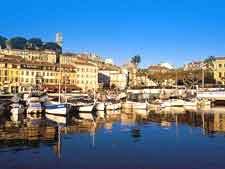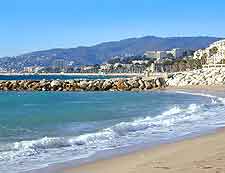Cannes History Facts and Timeline
(Cannes, Alpes-Maritimes, Provence-Alpes-Cote d'Azur, France)

Nowadays, Cannes is best known for its film festival. Less well known is the fact that this buzzing resort has a rich history that stretches back thousands of years.
Cannes' origins date to around the 2nd century BC, when a group of people known as the Oxybians settled here. They were ousted by the Romans, who set up a garrison in the village. A fort was built on Le Suquet, a hill that is situated at the heart of the present-day city. It became known locally as the Castrum Canois, because of the reeds ('canna') found in the area. After the fall of the Roman Empire, Cannes fell victim to successive attacks by Barbarians from the north of Europe and Saracens from the south.
From the Middle Ages to the Renaissance
During the medieval era, Cannes came under the control of the Lérins. Its ruler was the abbot of the Abbaye of Lérins. A castle was built here, notably as a residence for the abbot, but also to protect the village against attack.
From the 13th to the 16th century, Cannes expanded to become a small town. This period in history was characterised by outbreaks of plague, including one particular incidence in 1520 that killed more than half of its population. The town was also disrupted by the constant threat of attack from rogue bandits. Nonetheless, Cannes survived, ruled by Catalan and Angevin counts. By the 17th century, it had grown into a town of some 600 homes.
Birth of a Famous Resort
In 1834, Lord Brougham, a former Lord Chancellor of England, was detained in Cannes during a trip to Italy. The reason for his unplanned stay was a cholera outbreak that temporarily prevented him from travelling on to
Nice. He liked the place so much that he decided to build himself a villa at the Croix des Gardes. Many people came to visit him here, particularly those wishing to escape an English winter.
Such visitors included Guy de Maupassant and Stephen Liegeard, who coined the name for this part of the southern French coast, the 'Côte d'Azur'. The Empress of Russia also came to Cannes, accompanied by the entire royal court, in the hope that its climate would help to return her to good health. Some visitors liked the place so much, they also decided to build houses here and thus, what had been little more than a small town grew into a resort.

19th-Century History Onwards
In 1838, work began on building a pier, which subsequently attracted the yachting community. Next came the Casino Municipal and the Esplanade des Alliés. By the end of the 19th century, Cannes was home to many large 'Belle Epoque' villas and hotels. These included the famous Carlton Hotel, which opened its doors to fashionable members of the English aristocracy.
The 20th century brought war to Cannes. During World War One, many large buildings were requisitioned and used to treat the wounded. After the war, modernisation came to the city, including the building of schools and, in the 1920s, tourism began to grow. By this time, it had become fashionable to sunbathe. What's more, the city was much more accessible to the lower classes. During World War Two, the city was occupied by German and Italian forces. The liberation by the Americans in 1944 is said to have famously involved the American actor Mr. Douglas Fairbanks Jr, who captained a US naval ship.
The Cannes Film Festival was officially established in 1946, just after the end of World War Two. The Festival remains the pride of the city.
 Nowadays, Cannes is best known for its film festival. Less well known is the fact that this buzzing resort has a rich history that stretches back thousands of years.
Nowadays, Cannes is best known for its film festival. Less well known is the fact that this buzzing resort has a rich history that stretches back thousands of years.